Themed collection 2014 Emerging Investigators

Contributors to the Emerging Investigators Issue 2014
Chem. Commun., 2014,50, 5100-5114
https://doi.org/10.1039/C4CC90109F
Structure of catalyst particles from in-situ electron microscopy: a web themed issue
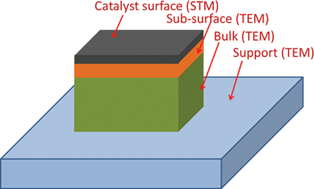
Chem. Commun., 2014,50, 12417-12419
https://doi.org/10.1039/C4CC90211D
Chemical consequences of mechanical bonding in catenanes and rotaxanes: isomerism, modification, catalysis and molecular machines for synthesis
We highlight some of the less discussed consequences of mechanical bonding for the chemical behaviour of catenanes and rotaxanes, including striking recent examples where molecular motion controls chemical reactions.
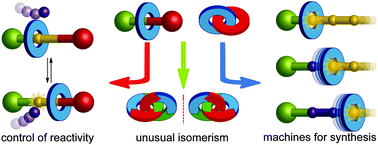
Chem. Commun., 2014,50, 5128-5142
https://doi.org/10.1039/C3CC47842D
Metal–metal multiple bonding in C3-symmetric bimetallic complexes of the first row transition metals
Recent achievements in the area of metal–metal multiple bonding are highlighted using C3-symmetric systems as a model to better understand the fundamental aspects of multiple bonds featuring first row transition metals.
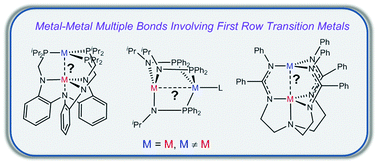
Chem. Commun., 2014,50, 5115-5127
https://doi.org/10.1039/C3CC47537A
Linear neutral platinum–acetylide moiety: beyond the links
This feature article presents a brief review on the linear neutral platinum–acetylide moiety, trans-Pt(PR3)2(C![[triple bond, length as m-dash]](https://www.rsc.org/images/entities/char_e002.gif) CR′)2.
CR′)2.
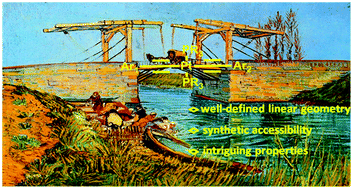
Chem. Commun., 2014,50, 5171-5186
https://doi.org/10.1039/C3CC47485B
Engineering ultrasmall water-soluble gold and silver nanoclusters for biomedical applications
With some critical biological considerations, biomolecule-protected gold and silver nanoclusters were identified to be suitable for biomedical applications, and efficient synthetic strategies and potential biomedical applications of these nanoclusters were discussed.
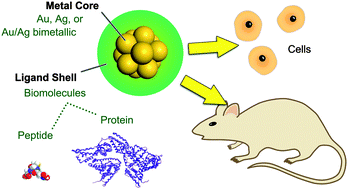
Chem. Commun., 2014,50, 5143-5155
https://doi.org/10.1039/C3CC47512C
Recent progress in the construction of cavity-cored supramolecular metallodendrimers via coordination-driven self-assembly
This feature article reviews the recent progress in the construction of cavity-cored supramolecular metallodendrimers via coordination-driven self-assembly.
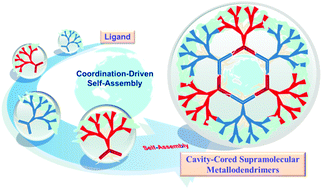
Chem. Commun., 2014,50, 5156-5170
https://doi.org/10.1039/C3CC47484D
Deuterated carbohydrate probes as ‘label-free’ substrates for probing nutrient uptake in mycobacteria by nuclear reaction analysis
Deuterated sugars that are transported into mycobacteria can be detected using ion beam (nuclear reaction) analysis.

Chem. Commun., 2015,51, 4838-4841
https://doi.org/10.1039/C4CC09588J
Preparation of a “twisted basket” Mn4N8 cluster: a two-hydrogen-atom reduced analogue of the Mn4N8 pinned butterfly
Mn4(μ-NHPh)4(μ-PhNNPh-κ2N,N′)2(py)4 (3) is synthesized via self assembly from fragments or via HAT to Mn4(μ-NHPh)2(μ3-PhNNPh-κ3N,N′)2(μ-PhNNPh-κ2N,N′)(py)4 (2) (R = SiMe3).

Chem. Commun., 2014,50, 7780-7782
https://doi.org/10.1039/C4CC02872D
68Ga chelating bioorthogonal tetrazine polymers for the multistep labeling of cancer biomarkers
There has been significant interest in the use of bioorthogonal inverse Diels–Alder cycloadditions in molecular imaging. We have developed metal chelating tetrazine probes that extend tetrazine cycloadditions to the convenient and generator produced positron emitting isotope gallium-68 (68Ga).
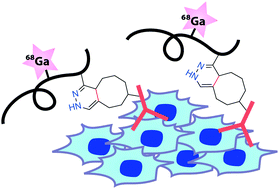
Chem. Commun., 2014,50, 5215-5217
https://doi.org/10.1039/C3CC49530B
Enhanced activity and stability of organophosphorus hydrolase via interaction with an amphiphilic polymer
A simple approach to enhancing the activity and stability of organophosphorus hydrolase (OPH) is developed based on interactions between the hydrophobic poly(propylene oxide) (PPO) block of amphiphilic Pluronics and the enzyme.
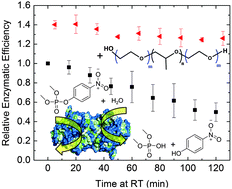
Chem. Commun., 2014,50, 5345-5348
https://doi.org/10.1039/C3CC47675H
Resonance-Raman spectro-electrochemistry of intermediates in molecular artificial photosynthesis of bimetallic complexes
Short lived reactive intermediates during photoinduced multielectron transfer have been studied by in situ UV-vis and RR spectro-electrochemistry revealing the impact of individual electronic transitions on the efficiency of a H2 evolving photocatalyst.
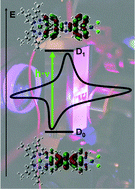
Chem. Commun., 2014,50, 5227-5229
https://doi.org/10.1039/C3CC47487A
Catalytic nanoreactors in continuous flow: hydrogenation inside single-walled carbon nanotubes using supercritical CO2
One nanometre wide carbon nanoreactors are utilised as the reaction vessel for catalytic chemical reactions on a preparative scale.
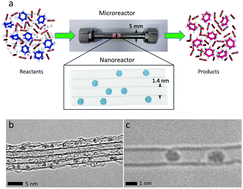
Chem. Commun., 2014,50, 5200-5202
https://doi.org/10.1039/C3CC49247H
Early amyloid β-protein aggregation precedes conformational change
The aggregation of amyloid-β protein (1–42) is studied at experimental concentrations using all-atom molecular dynamics simulations.

Chem. Commun., 2014,50, 5373-5375
https://doi.org/10.1039/C3CC48704K
Binding behaviors of protein on spatially controlled poly[oligo(ethylene glycol) methacrylate] brushes grafted from mixed self-assembled monolayers on gold
Binding behaviors of streptavidin were investigated with different lateral packing densities of biotin-functionalized non-biofouling pOEGMA brushes, synthesized by surface-initiated polymerization from mixed SAMs.
![Graphical abstract: Binding behaviors of protein on spatially controlled poly[oligo(ethylene glycol) methacrylate] brushes grafted from mixed self-assembled monolayers on gold](/en/Image/Get?imageInfo.ImageType=GA&imageInfo.ImageIdentifier.ManuscriptID=C3CC47055E&imageInfo.ImageIdentifier.Year=2014)
Chem. Commun., 2014,50, 5291-5293
https://doi.org/10.1039/C3CC47055E
A dual site catalyst for mild, selective nitrile reduction
A novel ruthenium bis(pyrazolyl)borate catalyst exhibits useful reactivity in ammonia borane dehydrogenation and water oxidation. It also enables unprecedented cooperative reduction reactivity in which boron and ruthenium centers work in concert to effect surprisingly selective nitrile reduction.
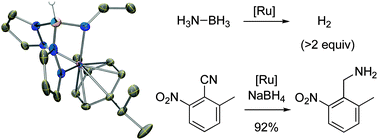
Chem. Commun., 2014,50, 5391-5393
https://doi.org/10.1039/C3CC47384H
Synergetic plasmonic effect of Al and Au nanoparticles for efficiency enhancement of air processed organic photovoltaic devices
Small diameter Au NPs and large diameter Al NPs are dispersed into the photoactive layer of OPVs in order to synergistically contribute to optical absorption enhancement by plasmonic and scattering effects respectively.
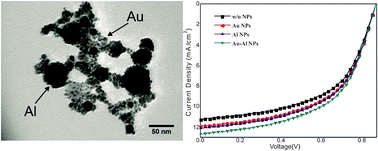
Chem. Commun., 2014,50, 5285-5287
https://doi.org/10.1039/C3CC49004A
Organocatalytic photoreduction of Zn(II) to zinc metal
The photoreduction of Zn(II) to Zn metal catalyzed by 8-hydroxyquinoline derivatives is reported.
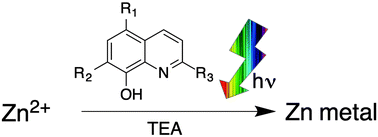
Chem. Commun., 2014,50, 5196-5199
https://doi.org/10.1039/C3CC47633B
Photo-tunable multicolour fluorescence imaging based on self-assembled fluorogenic nanoparticles
Non-fluorescent nanoparticles formed via self-assembly of a perylene-diimide behave as fluorogenic probes that give a dosage-dependent green or red fluorescence in cells. Photo-irradiation allows us to achieve multicolour labelling.
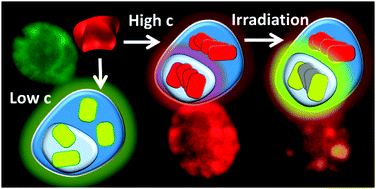
Chem. Commun., 2014,50, 5326-5329
https://doi.org/10.1039/C3CC48464E
Synthesis of squaraine dyes under mild conditions: applications for labelling and sensing of biomolecules
We report the synthesis of squaraine dyes under mild conditions by carbodiimide activation of squaric acid or semi-squaraine dyes.
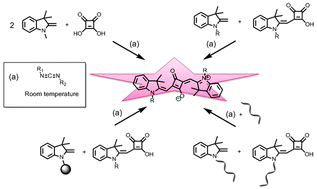
Chem. Commun., 2014,50, 5288-5290
https://doi.org/10.1039/C3CC47894G
Control of cytochrome c redox reactivity through off-pathway modifications in the protein hydrogen-bonding network
Mutations off the dominant electron-transfer pathways have strong effects on the redox reactivity of cytochrome c.
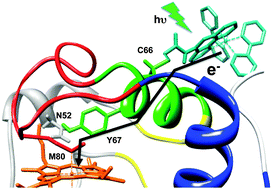
Chem. Commun., 2014,50, 5355-5357
https://doi.org/10.1039/C3CC47943A
Charge-modulated self-assembly and growth of conjugated polyelectrolyte–polyoxometalate hybrid networks
The self-assembly of an anionic polyoxometalate (POM) with cationic π-conjugated polyelectrolytes (CPE) leads to hybrid supramolecular networks whose dimensionality is controlled by the chain length and steric charge distribution.
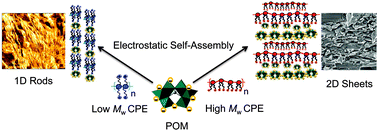
Chem. Commun., 2014,50, 5233-5235
https://doi.org/10.1039/C3CC47552B
Potent, selective small molecule inhibitors of type III phosphatidylinositol-4-kinase α- but not β-inhibit the phosphatidylinositol signaling cascade and cancer cell proliferation
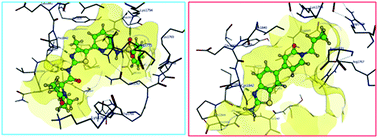
Chem. Commun., 2014,50, 5388-5390
https://doi.org/10.1039/C3CC48391F
Synthesis of the 6,6,5,7-tetracyclic core of daphnilongeranin B
An efficient approach toward the synthesis of the 6,6,5,7-tetracyclic core of the daphnilongeranin B, a Daphniphyllum alkaloid, is reported.
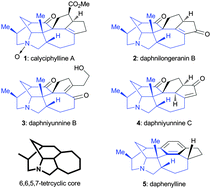
Chem. Commun., 2014,50, 5294-5297
https://doi.org/10.1039/C3CC47873D
Dye-sensitized solar cells based on multichromophoric supramolecular light-harvesting materials
Dye-sensitized solar cells comprised of supramolecular light-harvesting zinc-phthalocyanine⋯peryleneimide dyads on TiO2 films generate photoelectricity throughout the 300–650 nm region with the power conversion efficiency reaching up to 2.3% and the incident-photon-to-current-efficiency up to 40% under one-sun conditions.
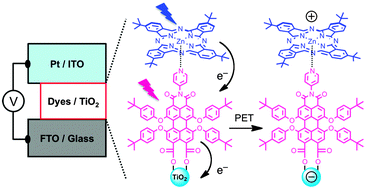
Chem. Commun., 2014,50, 5358-5360
https://doi.org/10.1039/C3CC47498D
A small molecule that displays marked reactivity toward copper– versus zinc–amyloid-β implicated in Alzheimer's disease
A small molecule was designed for reactivity toward Cu(II)–amyloid-β over Zn(II)–amyloid-β, which will expand on the development of chemical tools to uncover the role of metal–Aβ species in Alzheimer's disease.
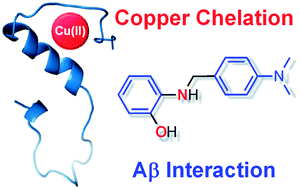
Chem. Commun., 2014,50, 5301-5303
https://doi.org/10.1039/C3CC48473D
Surface modification of metal oxides by polar molecules in a non-polar, polarizable solvent system
A simple yet general approach for modifying metal oxide surfaces using polar compounds in a non-polar polarizable solvent is presented.
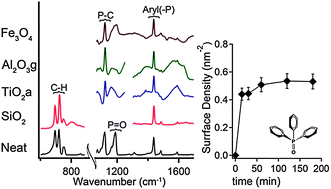
Chem. Commun., 2014,50, 5397-5399
https://doi.org/10.1039/C3CC47140C
Negative area compressibility in silver(I) tricyanomethanide
Under hydrostatic pressure, crystals of silver tricyanomethanide actually expand in two orthogonal directions.

Chem. Commun., 2014,50, 5264-5266
https://doi.org/10.1039/C3CC47032F
Counterion effects in the catalytic stereoselective synthesis of 2,3′-pyrrolidinyl spirooxindoles
A Lewis acid-catalyzed stereoselective [3+2] annulation of crotylsilanes with iminooxindoles is reported to access 2,3′-pyrrolidinyl spirooxindoles with four stereocenters.
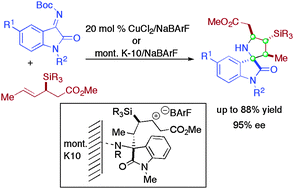
Chem. Commun., 2014,50, 5242-5244
https://doi.org/10.1039/C3CC47767C
Manipulating the optical properties of symmetrically branched Au/Pd nanocrystals through interior design
Through interior design, the optical properties of bimetallic nanocrystals can be facilely manipulated.
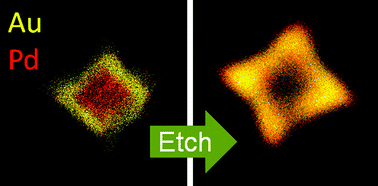
Chem. Commun., 2014,50, 5367-5369
https://doi.org/10.1039/C3CC48441F
Pyridine-2-thiolate bridged tin–palladium complexes with Sn(PdN2Cl2), Sn(PdN2S2), Sn(PdN2C2) and Sn(Pd2N4) skeletons
Pyridine-2-thiolate tin(IV) compounds were shown to chelate Pd(0) in a pincer-like fashion with formation of penta- and hexacoordinate tin compounds.
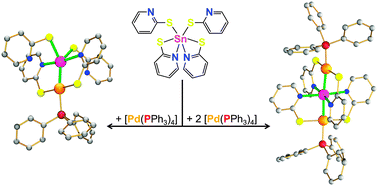
Chem. Commun., 2014,50, 5382-5384
https://doi.org/10.1039/C3CC47912A
Investigating magneto-chemical interactions at molecule–substrate interfaces by X-ray photo-emission electron microscopy
Seeing is believing – visualizing magnetic exchange coupling across the molecule–substrate spin-interface by X-ray photo-emission electron microscopy.
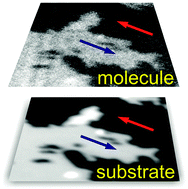
Chem. Commun., 2014,50, 5190-5192
https://doi.org/10.1039/C3CC47726F
E–H (E = R3Si or H) bond activation by B(C6F5)3 and heteroarenes; competitive dehydrosilylation, hydrosilylation and hydrogenation
Addition of R3Si–H–B(C6F5)3 to heteroarenes leads to surprisingly complex and substrate dependent mixtures due to competing dehydrosilylation, hydrosilylation and hydrogenation.

Chem. Commun., 2014,50, 5270-5272
https://doi.org/10.1039/C3CC47372D
C–C bond migration in the cycloisomerization of oxygen-tethered 1,6-enynes
Platinum- and iridium-catalyzed cycloisomerizations have been achieved that feature unique C–C bond migrations onto the metal carbene intermediate.

Chem. Commun., 2014,50, 5239-5241
https://doi.org/10.1039/C3CC47499B
A porous metal–metalloporphyrin framework featuring high-density active sites for chemical fixation of CO2 under ambient conditions
A porous metal–metalloporphyrin framework, MMPF-9, which features a high density of active sites in the nanoscopic channels, can efficiently catalyze the conversion of CO2 into cyclic carbonates under ambient conditions.
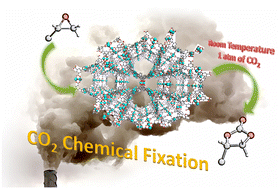
Chem. Commun., 2014,50, 5316-5318
https://doi.org/10.1039/C3CC47542E
Label-free luminescence switch-on detection of T4 polynucleotide kinase activity using a G-quadruplex-selective probe
A label-free, oligonucleotide-based, switch-on luminescence detection method for T4 polynucleotide kinase activity has been developed using a novel G-quadruplex-selective luminescent Ir(III) complex probe.

Chem. Commun., 2014,50, 5313-5315
https://doi.org/10.1039/C3CC47444E
Enhanced oxidative stability of non-Grignard magnesium electrolytes through ligand modification
A series of non-Grignard Mg-electrolytes with various para-substituents was synthesized starting from commercially-available phenols.
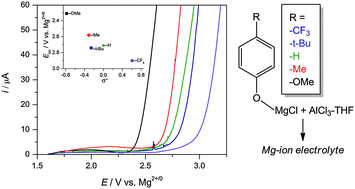
Chem. Commun., 2014,50, 5193-5195
https://doi.org/10.1039/C3CC47277A
A family of oxide–carbide–carbon and oxide–nitride–carbon nanocomposites
This paper describes a powerful and versatile new approach to oxide–carbide–carbon or oxide–nitride–carbon nanocomposites from sol–gel precursors.
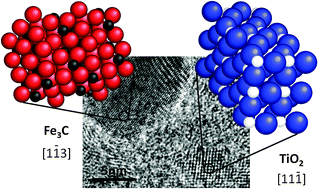
Chem. Commun., 2014,50, 5364-5366
https://doi.org/10.1039/C3CC47480A
Small molecule-based tandem solar cells with solution-processed and vacuum-processed photoactive layers
A tandem solar cell device whose sub-cells are fabricated exclusively from small molecules (SMs) through both solution-processed and vacuum-processed deposition techniques is described.
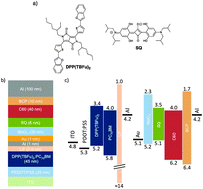
Chem. Commun., 2014,50, 5349-5351
https://doi.org/10.1039/C3CC47333C
A prototype point-of-use assay for measuring heavy metal contamination in water using time as a quantitative readout
The combination of aptamers, depolymerizable poly(carbamates), and paper enables selective, sensitive, and quantitative assays for heavy metal contamination of drinking water using only measurements of time as the readout.
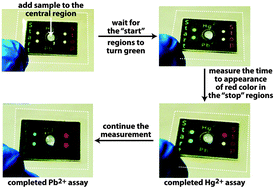
Chem. Commun., 2014,50, 5352-5354
https://doi.org/10.1039/C3CC47698G
Direct grafting of poly(pentafluorophenyl acrylate) onto oxides: versatile substrates for reactive microcapillary printing and self-sorting modification
Poly(pentafluorophenyl acrylate) was covalently grafted to surfaces and used as a scaffold for postpolymerization modification, generating spatially controlled chemical functionality.
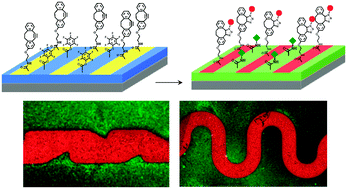
Chem. Commun., 2014,50, 5307-5309
https://doi.org/10.1039/C3CC47597B
Group 3 metal stilbene complexes: synthesis, reactivity, and electronic structure studies
Group 3 metal (E)-stilbene complexes supported by a ferrocene diamide ligand were synthesized and characterized. Experimental and computational results indicated that the double bond was reduced and not a phenyl ring, in contrast to a previously reported uranium (E)-stilbene complex.
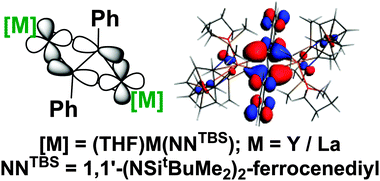
Chem. Commun., 2014,50, 5221-5223
https://doi.org/10.1039/C3CC47505K
Tracking chemical reactions on the surface of filamentous phage using mass spectrometry
A method based on mass spectrometry was developed to follow chemical modifications applied to phage-encoded polypeptide libraries.
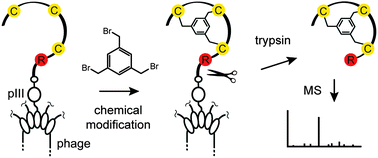
Chem. Commun., 2014,50, 5267-5269
https://doi.org/10.1039/C3CC47496H
A photo-induced C–O bond formation methodology to construct tetrahydroxanthones
A metal-free, photo-induced C–O bond formation methodology was developed to construct tetrahydroxanthones. This mild and efficient methodology was based on intramolecular oxygen trapping of the reactive species produced by photolytic activation of a C–Cl bond.

Chem. Commun., 2014,50, 5254-5257
https://doi.org/10.1039/C3CC47426G
Overcharge performance of 3,7-disubstituted N-ethylphenothiazine derivatives in lithium-ion batteries
When an overcharging battery reaches a potential that matches the oxidation potential of redox shuttle electrolyte additives such as phenothiazine derivatives, the additives oxidize, shuttling between electrodes in radical cation and neutral forms, mitigating excess current, thus stabilizing voltage.
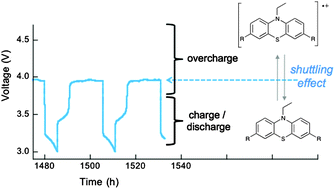
Chem. Commun., 2014,50, 5339-5341
https://doi.org/10.1039/C3CC47503D
Oxidative C(sp3)–H bond cleavage, C–C and C![[double bond, length as m-dash]](https://www.rsc.org/images/entities/char_e001.gif) C coupling at a boron center with O2 as the oxidant mediated by platinum(II)
C coupling at a boron center with O2 as the oxidant mediated by platinum(II)
Platinum(II) 1,5-cyclooctanediyldi(2-pyridyl)borates react with O2via C(sp3)–H bond cleavage and stepwise C–C and C![[double bond, length as m-dash]](https://www.rsc.org/images/entities/char_e001.gif) C coupling of the borate ligand.
C coupling of the borate ligand.
![Graphical abstract: Oxidative C(sp3)–H bond cleavage, C–C and C [[double bond, length as m-dash]] C coupling at a boron center with O2 as the oxidant mediated by platinum(ii)](/en/Image/Get?imageInfo.ImageType=GA&imageInfo.ImageIdentifier.ManuscriptID=C3CC47445C&imageInfo.ImageIdentifier.Year=2014)
Chem. Commun., 2014,50, 5376-5378
https://doi.org/10.1039/C3CC47445C
Furan fused V-shaped organic semiconducting materials with high emission and high mobility
Dinaphtho[2,3-b:2′,3′-d]furan (DNF–V) derivatives with high blue emission in solid have been facially synthesized by using dehydration as a key step. A solution-crystallized thin film transistors based on alkylated DNF–V derivatives showed an excellent carrier mobility of more than 1 cm2 V−1 s−1.
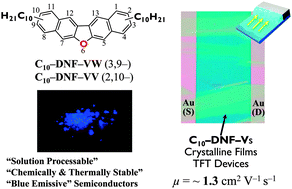
Chem. Commun., 2014,50, 5342-5344
https://doi.org/10.1039/C3CC47577H
A simplified culture system to examine soluble factor interactions between mammalian cells
A cell co-culture system is described that is simple to construct and is compatible with standard cellular and molecular assays.
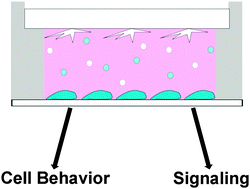
Chem. Commun., 2014,50, 5279-5281
https://doi.org/10.1039/C3CC47507G
Karrikins from plant smoke modulate bacterial quorum sensing
The discovery that plant smoke contains germination stimuli, named karrikins, has now led to the identification of a new role for these signals as quorum sensing modulators.
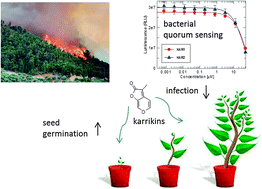
Chem. Commun., 2014,50, 5322-5325
https://doi.org/10.1039/C3CC47501H
A molecular rotor for measuring viscosity in plasma membranes of live cells
We report the viscosity imaging of the plasma membrane of live cells using a new targeted BODIPY-based molecular rotor.
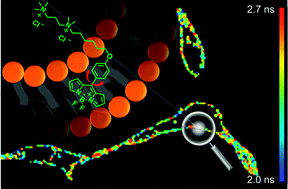
Chem. Commun., 2014,50, 5282-5284
https://doi.org/10.1039/C3CC47530A
A two-dimensional hydrogen bonded organic framework self-assembled from a three-fold symmetric carbamate
A hydrogen bonded organic framework displayed a capacity for accommodating and releasing guest molecules.

Chem. Commun., 2014,50, 5209-5211
https://doi.org/10.1039/C3CC47159D
Catalytic intermolecular β-C–H alkenylation of α-enamino-ketones with simple alkynes
A unique strategy to synthesize β-alkenyl-α-amino-enones via catalytic C–H/alkyne coupling is described.
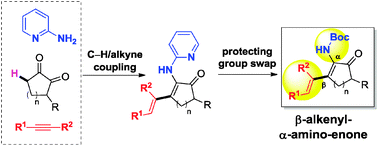
Chem. Commun., 2014,50, 5230-5232
https://doi.org/10.1039/C3CC47556E
Targeting cancer cells with folic acid–iminoboronate fluorescent conjugates
Herein we present the synthesis of fluorescent 2-acetylbenzeneboronic acids that undergo B–N promoted conjugation with lysozyme and N-(2-aminoethyl) folic acid (EDA-FA), generating conjugates that are selectively recognized and internalized by cancer cells that over-express folic acid receptors.
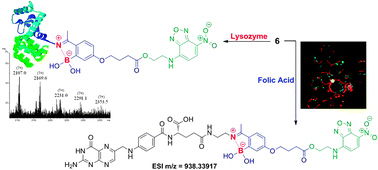
Chem. Commun., 2014,50, 5261-5263
https://doi.org/10.1039/C3CC47534D
Diaryl-substituted norbornadienes with red-shifted absorption for molecular solar thermal energy storage
Red-shifting the absorption of norbornadienes (NBDs), into the visible region, enables the photo-isomerization of NBDs to quadricyclanes (QCs) to be driven by sunlight.
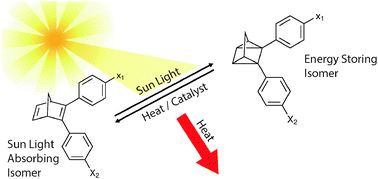
Chem. Commun., 2014,50, 5330-5332
https://doi.org/10.1039/C3CC47517D
Spectroscopic characterization of a phenolate bound FeII–O2 adduct: gauging the relative “push” effect of a phenolate axial ligand
Gauging the trans effect of phenolate.
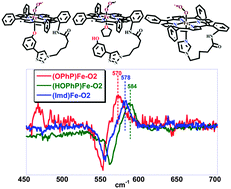
Chem. Commun., 2014,50, 5218-5220
https://doi.org/10.1039/C3CC47528J
Simple procedure for mono- and bis-end-functionalization of regioregular poly(3-hexylthiophene)s using chalcogens
Simple quenching method to synthesize mono- and bis-end-functionalized regioregular poly(3-hexylthophene)s using chalcogens is presented.

Chem. Commun., 2014,50, 5310-5312
https://doi.org/10.1039/C3CC47560C
Mechanosynthesis of pharmaceutically relevant sulfonyl-(thio)ureas
Solvent-free mechanochemical coupling provides pharmaceutically relevant sulfonyl-(thio)ureas, including anti-diabetic drugs tolbutamide, chlorpropamide and glibenclamide, rapidly and in high yield.
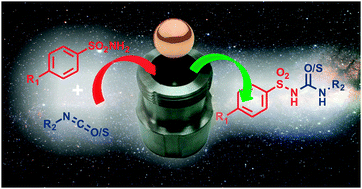
Chem. Commun., 2014,50, 5248-5250
https://doi.org/10.1039/C3CC47905F
Gold(I) mediated rearrangement of [7]-helicene to give a benzo[cd]pyrenium cation embedded in a chiral framework
The facile gold-mediated skeletal rearrangement of [7]-helicene into a cationic polyaromatic hydrocarbon is described.
![Graphical abstract: Gold(i) mediated rearrangement of [7]-helicene to give a benzo[cd]pyrenium cation embedded in a chiral framework](/en/Image/Get?imageInfo.ImageType=GA&imageInfo.ImageIdentifier.ManuscriptID=C3CC46986G&imageInfo.ImageIdentifier.Year=2014)
Chem. Commun., 2014,50, 5251-5253
https://doi.org/10.1039/C3CC46986G
Investigating the reactivities of a polyketide synthase module through fluorescent click chemistry
A method for monitoring in vitro polyketide synthesis has been developed whereby nonchromophoric polyketide products are made brightly fluorescent in a simple, rapid, inexpensive, and bioorthogonal manner through CuAAC with a sulforhodamine B azide derivative.
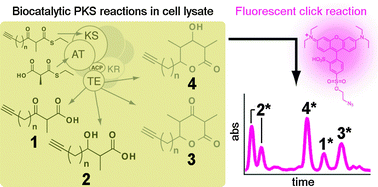
Chem. Commun., 2014,50, 5276-5278
https://doi.org/10.1039/C3CC47513A
Modulating guest binding in sulfonylcalixarene-based metal–organic supercontainers
A neutral metal–organic supercontainer (MOSC) has been functionalized as an anionic container, leading to enhanced adsorption capacity for polar guests.
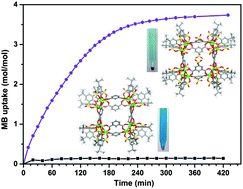
Chem. Commun., 2014,50, 5385-5387
https://doi.org/10.1039/C3CC47420H
The final unadorned tris(azolyl)borate: finishing what Trofimenko started in 1966
The final addition to the tris(azolyl)borate ligand family, tris(1,2,3-triazolyl)borate, has been synthesized.

Chem. Commun., 2014,50, 5273-5275
https://doi.org/10.1039/C3CC47151A
2-(Aryl-sulfonyl)oxetanes as designer 3-dimensional fragments for fragment screening: synthesis and strategies for functionalisation
Oxetane synthesis by intramolecular C–C bond formation efficiently provides 2-sulfonyloxetanes, which are further derivatised maintaining the oxetane ring intact.
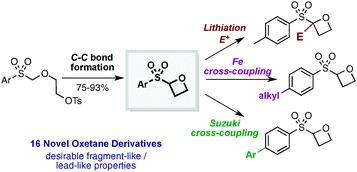
Chem. Commun., 2014,50, 5203-5205
https://doi.org/10.1039/C3CC46450D
Probing morphological changes in polymersomes with magnetic birefringence
Magnetic birefringence was used for in situ monitoring of the morphological changes in diamagnetic polymersomes during shape-transformation by dialysis.
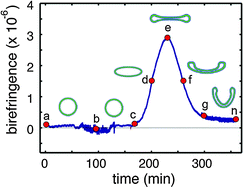
Chem. Commun., 2014,50, 5394-5396
https://doi.org/10.1039/C3CC47483F
Face-on stacking and enhanced out-of-plane hole mobility in graphene-templated copper phthalocyanine
The out-of-plane hole mobility in copper phthalocyanine is enhanced by face-on molecular stacking induced by graphene-templated growth.
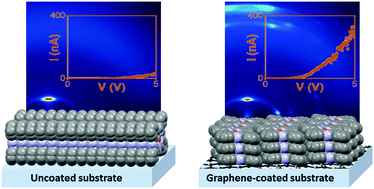
Chem. Commun., 2014,50, 5319-5321
https://doi.org/10.1039/C3CC47516F
A fluorogenic probe for recognizing 5-hydroxylysine inspired by serine/threonine ligation
A coumarin-based non-fluorescent probe can selectively react with 5-hydroxylysine-containing peptides, leading to a fluorescent tag.
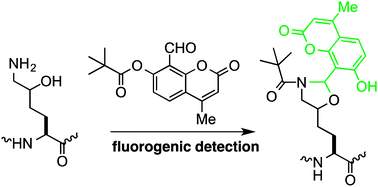
Chem. Commun., 2014,50, 5298-5300
https://doi.org/10.1039/C3CC47465H
Can non-polar hydrogen atoms accept hydrogen bonds?
A combined solution-phase and theoretical investigation reveals that Si–H can act as a fully neutral H-bond acceptor in solution, but only just.
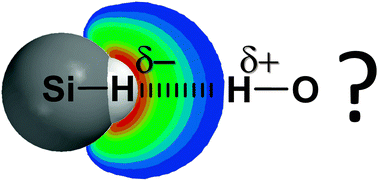
Chem. Commun., 2014,50, 5212-5214
https://doi.org/10.1039/C3CC46048G
Structural and electrochemical characterization of a cerium(IV) hydroxamate complex: implications for the beneficiation of light rare earth ores
Reaction of N-phenyl-pivalohydroxamic acid with CeIII precursors leads to a homoleptic hydroxamate complex: CeIV[tBuC(O)N(O)Ph]4.
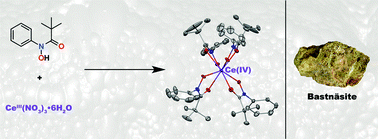
Chem. Commun., 2014,50, 5361-5363
https://doi.org/10.1039/C3CC46486E
An unprecedented CoII cuboctahedron as the secondary building unit in a Co-based metal–organic framework
A cubic metal–organic framework with an unprecedented octanuclear secondary building unit (SBU) was isolated.
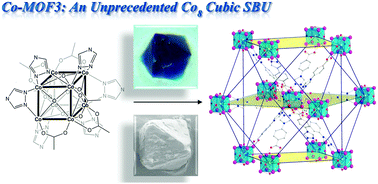
Chem. Commun., 2014,50, 5333-5335
https://doi.org/10.1039/C3CC46396F
Multifunctional squalene-based prodrug nanoparticles for targeted cancer therapy
Fluorescent and biotinylated squalene–gemcitabine prodrug nanoparticles exhibiting high drug payloads have been prepared and successfully used to target different cancer cell lines.
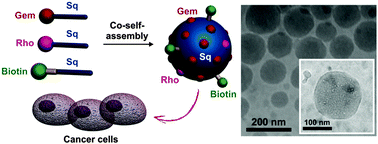
Chem. Commun., 2014,50, 5336-5338
https://doi.org/10.1039/C3CC47427E
Rhodium-catalyzed carbene transfer to alkynes via 2-furylcarbenes generated from enynones
A Rh-catalyzed cyclization of enynone, cyclopropenation of an alkyne and cyclopropene rearrangement cascade is accomplished using enynones as the carbene source.
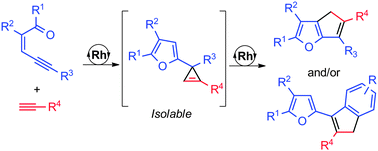
Chem. Commun., 2014,50, 5379-5381
https://doi.org/10.1039/C3CC47481J
About this collection
Welcome to the ChemComm Emerging Investigators Issue 2014. Now in its fourth year, we have been overwhelmed by the community's positive response to this issue. It showcases up-and-coming scientists who are internationally recognised for making outstanding contributions to their respective fields. New articles will be added to this collection as they are published.